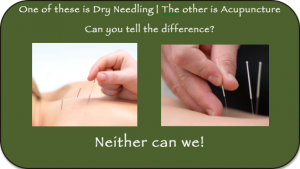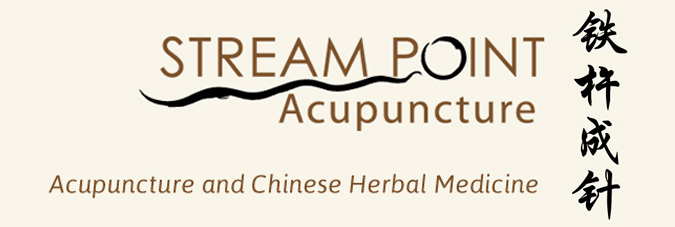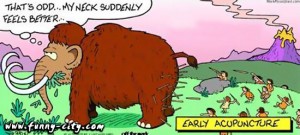 This week’s blog is dedicated to a somewhat controversial topic, so this is something that some of you may or may not resonate with. This particular topic is Dry Needling, which is a circulating buzzword in today’s healthcare platform. I will try to be unbias when presenting what Dry Needling is, but I will be honest off the bat – I, along with the rest of the Acupuncture Profession, are not in favor of Dry Needling for reasons explained below. But first, we need to explain what it is…
This week’s blog is dedicated to a somewhat controversial topic, so this is something that some of you may or may not resonate with. This particular topic is Dry Needling, which is a circulating buzzword in today’s healthcare platform. I will try to be unbias when presenting what Dry Needling is, but I will be honest off the bat – I, along with the rest of the Acupuncture Profession, are not in favor of Dry Needling for reasons explained below. But first, we need to explain what it is…
Dry Needling in a Nutshell
Dry needling is defined as the insertion of solid filament needles into myofascial trigger points to help heal tissues and decrease pain. I’ve added an image of common trigger points to the right. The mechanism of action is officially still “unknown” but practitioners of dry needling state that it works by eliciting a series of biochemical processes and local twitch responses. A local twitch response is literally when manipulation of a needle makes the muscle twitch; this is a spinal cord reflex, and an important part to resetting the muscle and stopping the pain cycle. The results in efficacy studies are highly similar to acupuncture studies in that results tend to be promising. Physical Therapists and Chiropractors do not learn Dry Needling in their traditional education programs, but instead learn it through Continuing Education seminars that last anywhere from a weekend to a few weeks. Dry Needling is currently practiced by Physical Therapists and Chiropractors around the world, and in various states in America.
The Controversy
With the growing popularity of Dry Needling in the western medical communities, much controversy has arisen. This is centered upon whether or not Dry Needling is Acupuncture and is therefore outside of the scope of practice of non-acupuncturists. In order to legally practice acupuncture, one must have completed an accredited acupuncture program (which is 3-5years), passed a national examination, and met standards for licensure in their state.
The Pro-Dry Needling Argument:
In order to get around the issue of scope of practice, non-acupuncture practitioners insist that Dry Needling isn’t acupuncture, and therefore is in their scope of practice because:
- They are not using Traditional Acupuncture Theory, only Biomedicine Theories
- They are not needling acupuncture points, they are needling myofascial trigger points.
- Dry Needling seminars do cover proper safety/clean needle techniques and all other necessary information to carry out Dry Needling safely and effectively.
The Anti-Dry Needling Argument
The Acupuncture Profession (both individual practitioners and national organizations) is ardently protesting Dry Needling claiming it is clearly acupuncture. As such, any non-acupuncture practitioner inserting acupuncture needles into the body is operating out of their scope of practice. Counter arguments are as follows:
- Dry Needling does extract from Traditional Acupuncture theory (specifically in the treatment of what is called Qi and Blood Stagnation and Bi Syndrome) it just doesn’t take it in its totality.
- Dry Needling does involve the insertion of needles into acupuncture points. Multiple studies have shown over 90% correspondence between myofascial trigger points and acupuncture points, not to mention the countless acupuncture “ashi points”. Ashi points are non-location-specific points used for the treatment of pain, and are selected based on whether or not pressure on that area triggers pain, or a knot is felt (aka…they are myofascial trigger points).
- While PTs and Chiros certainly go through their own rigorous training programs, it does not mean they are qualified to utilize acupuncture procedures in their practice. Many of these acupuncture points have multiple uses in acupuncture and are contraindicated for certain patients, especially pregnant women. Dry Needling courses do not cover these contraindications because the foundational theory does not correspond with western medicine.
- Example Gallbladder 21 (GB-21): GB-21 is a very powerful trigger point for the upper trapezius, however clinically this point directs Qi downward, making it a very dangerous point for pregnant women. But this fact is not mentioned in Dry Needling seminars, and since many pregnant women experience trapezius pain they are at risk when they see a Dry Needling practitioner instead of an acupuncturist.
Summary
In summation, Dry Needling may not use the entirety of Traditional Acupuncture, but it has taken a significant chunk of it and rebranded it in attempt to put it within their scope of practice despite their lack of complete training. Forgive me for my candor, but this is illegal, this is unethical, and this potentially poses serious safety concerns.
On the other hand, when seeing a fully licensed acupuncturist, patients will not only receive the same musculoskeletal benefits they would receive from Dry Needling, but they will also realize a state of whole health that is simply not possible with Dry Needling.
In other words, why see someone who has only read a chapter when you can see a master of the entire book?
The Common Ground
Because many patients do experience relief when they see a practitioner performing Dry Needling, I do feel a compromise can be reached.
1. Physical Therapists, Chiropractors and similar practitioners can enroll in an accredited acupuncture program without having to repeat any of their biomedicine classes. This leaves approximately 2100 hours of acupuncture and traditional theory education from qualified acupuncturists, with the additional 1000hour clinical residency. They may then take the National Acupuncture examination to become licensed acupuncturists in their state of choice.
2. Should they then want to continue their education using solely Biomedicine Theories, there is a great program called Sports Medicine Acupuncture (which our very own Hardin Field V is certified in!). “This program significantly expands upon fundamental TCM approaches to the treatment of sports and orthopedic conditions. It applies TCM principles to Western biomedical facts and uses Western biomedical facts to illustrate TCM principles, thereby truly integrating the salient principles of both medical practices” (Taken from https://www.sportsmedicineacupuncture.com/certification-program/#tab-id-2).
For those of you who have gone to a practitioner for Dry Needling, please know that I am not condemning you, you have the right to choose which practitioner you want to receive treatment from. And for those of you who practice Dry Needling, I urge you to reconsider what you’re doing and how it’s affecting healthcare today. I’m not about to take a seminar in physical rehabilitation and call myself a “rehabilitative acupuncturist”, so please don’t appropriate technique from our profession either. We can be respectful of each others scopes of practice and co-exist to bring the best healthcare possible to our patients.
Learn more about acupuncture and our wellness services by visiting our website: www.streampointwellness.com
And we can end things on a humorous note 🙂


